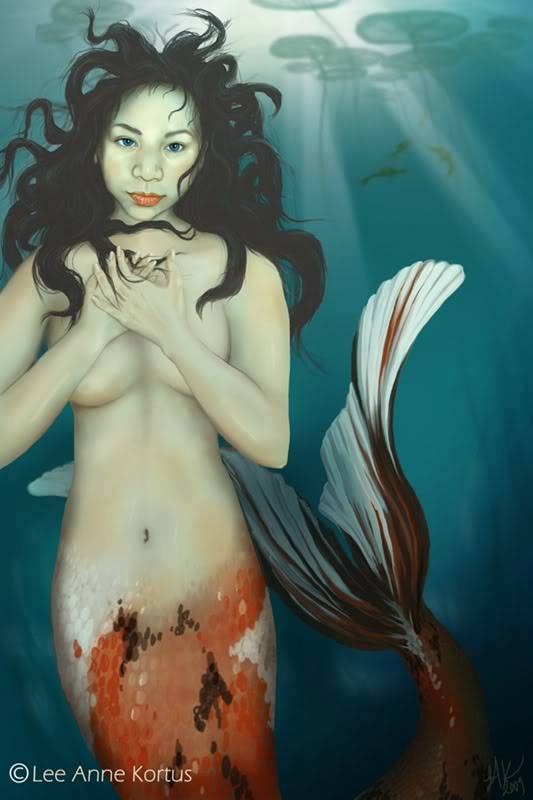

African folklore: the mermaids of the Karoo
The Karoo is a vast semi-desert area that covers much of the western half of South Africa – and is divided into the Groot Karoo (which means the ‘large’ Karoo in Afrikaans) in the north, and much more fertile, smaller Klein Karoo of the south – where many a local claims to have spotted a mermaid combing her hair alongside a mountain rock pool.
The legend seems far more plausible when you consider that 250 million years ago the stark, beautiful landscape of the Klein Karoo was completely underwater! When the oceans receded, they left behind a fertile valley that’s nestled between the Swartberg, Langeberg and Outeniqua mountains – where mountain springs trickle into the rock pools, and carve out the underground caverns that are said to provide sanctuary for this mythical creature.
The Klein Karoo was the home of the Khoi-san people, and rock paintings have been discovered that depict fish-tailed humans – suggesting that the legend of the Karoo mermaid has been around for centuries. It makes sense that a tribal people, living in one of the driest parts of South Africa, would have a sea creature as part of their mythology – a reminder, perhaps, of the importance of water as a resource that has always been precious.
It has been argued that the ‘fish people’ in the San rock painting rather depict swallows, which are also associated with rain. Shamans of the San tribes, who were a spiritual people, would have often conducted ceremonies to call down rain from the heavens, to parch the dry earth of their homelands. African mythology sparkles with tales of water spirits and creatures!
Traditionally, the mermaid is a symbol of both destruction and creation. It is a well-known sailor’s tale that sighting a mermaid means that violent storms are blowing in. As a symbol of the feminine life force, the mermaids of the Karoo could not be more at home – when the rains soak the arid plains, the Karoo bursts into life and colour, with succulent plants flowering in bright cheerful displays that attract photographers and tourists.
Mami Wata
Myth of mermaids is popular all around the world, but the African water spirit Mami Wata remained respected and celebrated from the time before the African nations came in contact with Europe, through the ages, and even up to today where she is venerated in West, Central, Southern Africa and the diaspora in Americas. She represented one of the most powerful goddesses in the African religion of Voudun (not to be mistaken to the newer and more heavily publicized Voodoo) and is today celebrated as a goddess that must be both loved and feared.
As with many other old mermaid deities such as Assyrian Astarte, Babylonian Ishtar and Greek Aphrodite, she is regarded as an immortal spirit that personifies polar opposites, such as of beauty and danger, natural force and healing, wealth and destruction, health and disease, and inability to follow ideas of good and evil. As those old mermaid deities, she is incredibly powerful, dangerous, pleasant, sexual and able to destroy anything on her path.
Her image in the minds of African followers went through little changes over the millennia. She is often portrayed as a long haired beautiful mermaid, half human and half fish, but sometimes she can walk the earth in more human body (but she never transforms completely into human form, always showing herself as a deity). Her clothes and jewelry are always new, shining, impossible to replicate, and she can be seen carrying small mirror, coiled snake that twist around her waist, breasts and head. This wealth symbolizes the wealth and beauty her followers can achieve, and interestingly her skin is fair and light, which is uncommon in the African pantheon of deities. Colors of Mami Wata’s attire carry great significance in African people. Red symbolizes the color of blood, violence and death, and white symbolizes spirituality, beauty and female body. In the mermaid form she is always represented naked, sometimes combing her long hair and looking at herself in the golden mirror.
Stories of the encounters with the Mami Wata are widespread across entire Africa. In most common version, she stalks the shores of the ocean and abducts men and women while they are swimming or traveling in a boat. If the goddess thinks that the captive is worthy of her attention, she will return them to the shore, completely dry and with changed attitude toward spirituality and religion that can often make them rich, attractive and famous. Other encounters tell the story of her leaving her comb and mirror in the presence of sailors. After they took the items she would haunt their dreams, requesting the return of the items in an exchange of eternal sexual favors.
Her devotees across Africa and diaspora wear her traditional colors of red and white, offer her items of wealth, expensive foods, and celebrate her in the rituals of dancing and music that induce trance like state. In such events, it is believed that Mami Wata can possess the dancers and speak to them, whishing them the successful, healthy and fertile life.
However as all deities that are water based, she is blamed for many of the misfortunes that happen in the sea. Even today, people of Cameroon believe that her wrath is killing the swimmers who are swept to the sea with the strong undertow water currents that flow near their coast.

